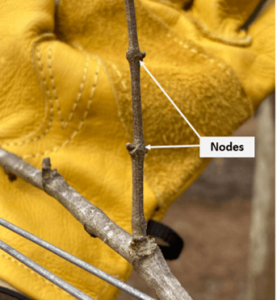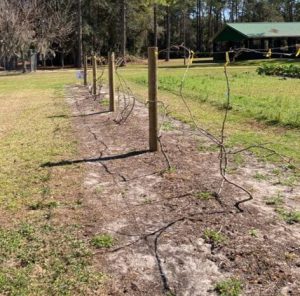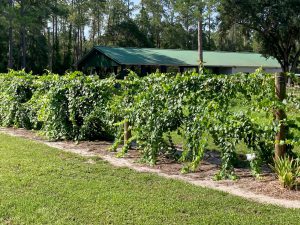The muscadine is believed to be one of the first native grape species cultivated in North America. Its fruit is popular in jellies, eating in hand, juice and winemaking. And, there is growing interest in muscadine sparkling wine!
To control explosive growth and enhance fruit production, Nature Coast Master Gardeners embarq on an annual vine pruning exercise. ‘Carlos’ is the variety found at Levy Extension Center. It’s self-fertile and used for wine or juice production with medium sized bronze grapes maturing around August to September. Major pruning is done during the dormant season. If green leaves are on the vine, wait until February or March to prune (Andersen et al, 2020).
Tools needed include bypass pruner, safety goggles, gloves, and a disinfectant to wipe down your equipment. Sharp bypass pruners have a scissor like action to neatly sever vines.
Anvil pruners should not be used. Anvil pruners crush the stem and should not be used on live grapevine.
The three-step process.
 Address the vine and identify cordon. Cordons are the left and right branches, primary “arms” on either side of the trunk. Fruit bearing shoots develop along the cordon.
Address the vine and identify cordon. Cordons are the left and right branches, primary “arms” on either side of the trunk. Fruit bearing shoots develop along the cordon.
 Canes and fruit bearing shoots develop along the cordon. Beginning at the trunk, move along the cordon and remove canes originating on the underside of the cordon. Those canes tend to be shaded and
Canes and fruit bearing shoots develop along the cordon. Beginning at the trunk, move along the cordon and remove canes originating on the underside of the cordon. Those canes tend to be shaded and
less productive. Removing canes originating from underside of cordon is recommended.- Space remaining canes/shoots about three to four inches apart along the cordon. Remove broken or unthrifty canes.
- Fruit develops on current year’s growth. Locate the nodes. The node is a slightly swollen portion of the cane. We shorten canes to keep the vine productive and manageable. Make a cut just above second or third node.
Sometimes clear sap seeps from the pruning cut. This does not hurt the plant. It is believed warm soil temperature; ambient air temperature and soil moisture causes the cut to “bleed.”

Use household hydrogen peroxide, 10% household bleach solution, or isopropyl alcohol to disinfect tools. For the latter two, rinse with clear water to remove those corrosive chemicals.

If you like to handle pruners and plant material, muscadine may be the vine for you (before pruning left image, after pruning right image)!
Many thanks to UF/IFAS Master Gardeners; Sue, Michael, Peter, Debra, Eugene, Lisa, Jim, Roger, Martha, Mary, and Guendolyn for assisting with these fun and educational videos. Until next time – Happy Gardening!

Resources cited: Peter Andersen, Ali Sarkhosh, Dustin Huff, and Jacque Breman, 2020, THE MUSCADINE GRAPE (VITIS ROTUNDIFOLIA MICHX)
 0
0
 Canes and fruit bearing shoots develop along the cordon. Beginning at the trunk, move along the cordon and remove canes originating on the underside of the cordon. Those canes tend to be shaded and
Canes and fruit bearing shoots develop along the cordon. Beginning at the trunk, move along the cordon and remove canes originating on the underside of the cordon. Those canes tend to be shaded and